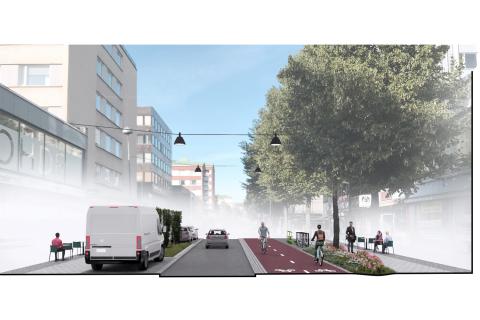Renovation of Puutarhakatu

After the renovation, the street will have a wider two-way cycle track on the northern edge, pavements on both sides and a one-way carriageway for motor vehicles. The renovation will improve walking and cycling conditions and road safety, and make the street a more pleasant environment. The management of stormwater, i.e. rainwater and meltwater, will also be improved.
Getting around and shopping on Puutarhakatu right now
The renovation of Puutarhakatu has started on 3.3.2025 from the intersections of Näsilinnankatu, Kuninkaankatu and the section between Kuninkaankatu and Aleksis Kiven katu The work will cause traffic disroptions, but the properties will be accessible by all means of transport. Through traffic on the street will be blocked during the excavation work on the carriageway. Pedestrians and cyclists will be able to travel between Aleksis Kivi Street and Hämeenpuisto.
Working hours start at 6 a.m. and end at 22 p.m. However, on Fridays, work will end at 19.30.
Traffic arragments from 31.3.
The construction of the storm and sewage drain will be moved to the south side of the Näsilinnankatu junction during the week due to future traffic changes. Minor, temporary changes to pedestrian and cycling routes will also be made as a result.
The cable trench at Puutarhakatu 21 will be moved to Puutarhakatu 19, and from there on towards the Vapaakirkko. Access to the properties will be secured by footbridges and driveways. Properties will be informed separately of any temporary interruptions.
At the Kuninkaankatu intersection, the renovation of the sewage and stormwater drainage system is progressing as planned. The removal of the old fire hydrant at Kuninkaankulma will result in a water cut planned for Monday 31 March from 22.00.
At the Kuninkaankatu junction, earthworks will be carried out as the renovation work progresses towards Näsilinnankatu, and the junction access routes will be opened up more widely. There may be other night-time works at Kuninkaankulma.
At the eastern end of the Puutarhakatu redevelopment, at Puutarhakatu 8, the construction of the stormwater trunk sewer is progressing towards the Kuninkaankatu junction.
The aim is to renovate as much as possible in one go, in cooperation between the different actors, so as to cause as little inconvenience as possible and in as short a time as possible.
The renovation of the City Hall and the construction of a new building at the corner of Puutarhakatu and Aleksis Kiven katu are also underway. City Hall and its new building will be completed in spring 2026.

Contact us
You can ask questions or give feedback about the Puutarhakatu project and the future construction site by email: puutarhakatu@tampereeninfra.fi
Your message will be forwarded to the right person.
Project actors
The City of Tampere is the main developer of the Puutarhakatu project. Tampere Water, Tampereen Energia Oy, Tampereen Energia Sähköverkko Oy and telecom operators are also involved. Tampereen Infra Oy is the main contractor of the project. Puutarhakatu will be renewed in cooperation between the parties involved.
The renovation of Puutarhakatu will allow properties bordering the street to improve the accessibility of entrances, for example by removing low thresholds and stairs.
